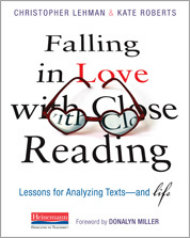Falling in Love with Close Reading: Lessons for Analyzing Texts & Life
Falling in Love with Close Reading: Lessons for Analyzing Texts and Life
By Christopher Lehman and Kate Roberts
(Heinemann, 2014 – Learn more)
Authors Christopher Lehman and Kate Roberts really meant it when they ended the subtitle to this book about close reading with the phrase “…and life.” While there is a lot to admire and to consider throughout the entirety of Falling in Love with Close Reading, I found myself most fascinated by the ways in which Roberts and Lehman connect the ideas behind careful reading of text (of all stripes) with the lives of young readers.
 ► In a chapter about studying the structure of text, Lehman and Roberts suggest helping students to examine the structures of their own lives, from school and home scheduling, to tracking what one actually does during unscheduled times, to running experiments on changing the structure of your day to see what might happen.
► In a chapter about studying the structure of text, Lehman and Roberts suggest helping students to examine the structures of their own lives, from school and home scheduling, to tracking what one actually does during unscheduled times, to running experiments on changing the structure of your day to see what might happen.
► Another chapter on point of view and argument ends with having young people take a step back from a recent argument with family or a friend, in order to break down the techniques they unwittingly used or didn’t use, and to study newspapers and television shows and even the coverage of pop stars for the ways in which argument unfolds in a natural setting beyond the page.
These kinds of interesting asides breathe fresh air into what could be a tedious look at this term of “close reading” now popping up in Common Core-related material.
So, what is close reading, anyway?
Roberts and Lehman, both of whom have connections to the Teachers College Reading and Writing Project, work out the main elements of the idea by stating that close reading is:
► The purposeful interaction between a reader and a text;
► The making of careful observations, and then the making of reasonable interpretations from those observations;
► The systematic and focused re-reading of texts, or even small sections, to carry new ideas forward into the larger text itself.
Each chapter develops a strand or lens of close reading, and like Lehman’s other books (most notably Energize Research Reading and Writing), the authors here give a solid overview of the themes and then dive deeply into how a teacher might use the strategies and tools in the classroom, with script-like notes explaining in clear language how to set the stage for the learning. These sections include asides on what one can expect from a differentiated classroom, and there are samples of student work and anchor charts that situate the main ideas.
One handy chart follows many of the themes, too, as Lehman and Roberts suggest teaching students to develop an approach to close reading that begins with reading through a certain lens (such as word choice or text evidence), then finding a pattern around that lens, and then finally using the patterns to develop a new understanding of the text.
Students encounter many kinds of texts
The texts examined here are not just written words, either. The two authors acknowledge that young people get their information from a variety of sources, not just books and magazines, and we as teachers must adapt our close reading strategies for various kinds of media. I was pleasantly intrigued to see an entire lesson built around a close reading of television sitcoms as a way to teach synthesis or reading across multiple texts. In another chapter, the media focus is on the narrative elements of video games as a way to look at storytelling structure.
Falling in Love with Close Reading covers a lot of important ground, and for those of us who are struggling with the terminology now associated with the implementation of the Common Core, this is the kind of book that will help you make sense of the rationale of close reading strategies while also providing you with specific learning activities that can be adapted across grades, across the curriculum – and even into the lives of your students.
Kevin Hodgson is a sixth grade teacher in Southampton, Massachusetts, and is the technology liaison with the Western Massachusetts Writing Project. Kevin blogs regularly at Kevin’s Meandering Mind and tweets more often than is healthy under his @dogtrax handle. He also blogs about the ELA classroom here at MiddleWeb.




































I’m interested in purchasing this book. I teach freshmen. Do the strategies apply to high school students or students just learning how to read? Thanks!
I think the audience extends nicely into high school. Close reading strategies are important at many levels, particularly if we want our students to dig deeper into the context of the texts. I think you will find the book enlightening and powerful in terms of keeping the love of reading alive as well as nurturing some important skills.
Kevin